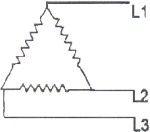Hi! I'm working on an electric kiln project in Europe and can't figure out why the B16 circuit breaker breaks the circuit after about 30 seconds of heating the elements. I've wired the elements in delta connection like in diagram below. Please take a look at my calculations and tell me where I went wrong. I have underlined the possible places where I went wrong in my calculations.

- 3 phases
- 380 volts
- 34 ohms resistance wire total (11.3 ohms between each two phases)
- 11.18 amperes of current flow - is this correct or is it 380/11.3= 33.6 amperes?
- 4248watts - or is it 380vX33.6A=12 768watts
- Kanthal wire 1.4mm diameter with resistance 0.94 ohms/meter
- used coiled resistance wire total length 36 meters
- watt loss is around 3 watts/mm2, which is acceptable for this kind of wire to heat up to about 1200celsius.
Thanks for your help!

- 3 phases
- 380 volts
- 34 ohms resistance wire total (11.3 ohms between each two phases)
- 11.18 amperes of current flow - is this correct or is it 380/11.3= 33.6 amperes?
- 4248watts - or is it 380vX33.6A=12 768watts
- Kanthal wire 1.4mm diameter with resistance 0.94 ohms/meter
- used coiled resistance wire total length 36 meters
- watt loss is around 3 watts/mm2, which is acceptable for this kind of wire to heat up to about 1200celsius.
Thanks for your help!

